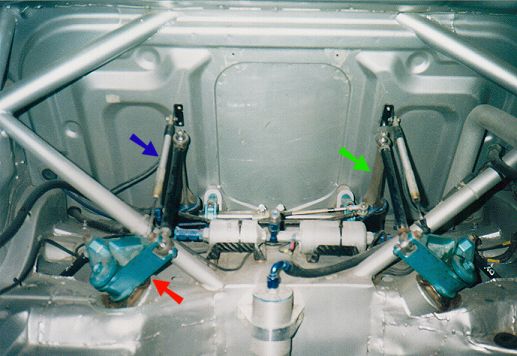 I saved the best for last. This is my favorite shot of the series. The photo is looking into
the trunk at the rear seat bulkhead. What is visible is the elaborate "bell-crank" mechanism
used to activate the rear anti-roll bar. The anti-roll bar is very short and is bolted to
the rear seat bulkhead. It integrates into the support braces that we saw in one of the first
pictures.
I saved the best for last. This is my favorite shot of the series. The photo is looking into
the trunk at the rear seat bulkhead. What is visible is the elaborate "bell-crank" mechanism
used to activate the rear anti-roll bar. The anti-roll bar is very short and is bolted to
the rear seat bulkhead. It integrates into the support braces that we saw in one of the first
pictures.
The red arrow points out one of the two blue anodized aluminum bell-cranks. The green arrow shoes the "blade-adjuster" for the rear anti-roll bar. This blade can be rotated from the cockpit. Variations of the orientation of the blade relative to the direction of applied force cause a change in the effective stiffness of the anti-roll bar. This is the most common method of achieving a cockpit adjustable anti-roll bar. The blue arrow highlights what appears to be a small damper, but is probably a sensor for rear wheel compression for the on-board telemetry system. The two canisters look like remote reservoirs for the rear shocks. But they are more likely fuel filters. Note the cool but totally unnecessary little carbon fiber brackets that these canisters are mounted to. Shows what one can do with a big budget 8^) When I first saw this photo I figured that the car used torsion bars for the rear springs. I am not that familiar with the E36 rear suspension but to me the angles of the bell cranks don't look quite right to support the torsion bar theory. That would mean the bell cranks are simply for the rear anti-roll bar. Seems like a lot of work to me but it sure is trick. |